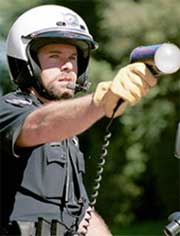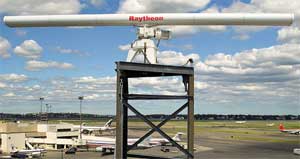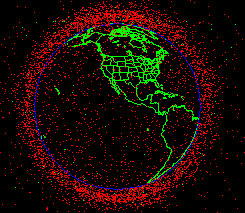Radar tracking
As its name suggests, tracking is the action of keeping track of where something is. It is one of the most essential functions performed by radar. Radar tracks storms, keeps air travel safe, makes space travel possible, protects nations from its enemies and can even get you a speeding ticket.
All types of radar work in the same basic way. A radar “illuminates” a target with invisible pulses of microwave energy. These pulses are very short, perhaps only a few millionths of a second. The target reflects the illumination and the radar then detects this reflection or “echo.” In this way, radar “sees” the target. In addition, by measuring the time it takes for the beam of microwave signal to leave the radar, reach the target, and come back, radar can determine the distance to the target. Finally, the way the target reflects the microwave beam can tell us the direction in which the target is moving.
Using radar to track things is useful in many places and in many situations. Airports are one of the most important places where radar is used. Radar is essential to effective air traffic control as it helps prevent collisions between airplanes. To track airplanes air traffic controllers rely on several different systems, some of which track airplanes near the airport and some that track airplanes several hundred miles away. Many of these radars are not necessarily placed at airports, but rather, are installed at strategic spots on the ground beneath air traffic lanes. Some of these radars are, of course, at airports. These are generally short-range radars that are intended to track airplanes, vehicles, and even individuals on the surface in and around the airport.
The military also relies heavily on radar for tracking purposes. They are used to keep track of friendly and enemy aircraft, missiles, ships, tanks, and other craft. For example, radar is used to monitor enemy targets to determine if they represent an immediate threat (that is, if they are approaching a sensitive area). If they are judged to be threatening, the radar will track the target and then be used to guide missiles or airplanes to intercept the enemy targets.
Radar is even useful in space. Used rocket stages and leftovers from completed missions, fragmented and inactive satellites, and objects that fly toward earth, such as asteroids, all orbit our planet. Radar is used to track this space debris, to determine if there’s a risk of any of it colliding with the International Space Station or the Space Shuttle. If it is determined that the ISS or Space Shuttle is in jeopardy a maneuver is carried out to get the craft out of the way.
These are just a few of the ways radar and its ability to track objects make us safer.


